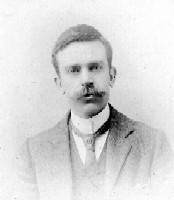 The Rucksack Club was formed in Manchester in 1902 by a group of men who responded to a letter written to a newspaper by two young men. They were invited to a meeting and resolved there and then to form a club with the object “To facilitate walking tours and mountaineering expeditions, both in the British Isles and elsewhere, and to particularly to initiate members into the science of rock climbing and snowcraft”.
The Rucksack Club was formed in Manchester in 1902 by a group of men who responded to a letter written to a newspaper by two young men. They were invited to a meeting and resolved there and then to form a club with the object “To facilitate walking tours and mountaineering expeditions, both in the British Isles and elsewhere, and to particularly to initiate members into the science of rock climbing and snowcraft”.
The new club was quickly into its stride. In the years before the First World War enthusiasm was great even if experience was limited and equipment meagre. Laddow Rocks was a favourite climbing ground: the photograph shows a rope of 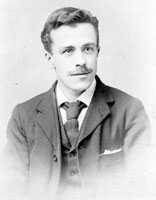 four on Tower Face. A good stance and a firm hold on the rope appear to suffice for protection. The photograph was taken by John Rooke Corbett, the Club’s Convener of Rambles. Subsequently Rooke Corbett became the fourth Munroist, (and the first such Sassenach).
four on Tower Face. A good stance and a firm hold on the rope appear to suffice for protection. The photograph was taken by John Rooke Corbett, the Club’s Convener of Rambles. Subsequently Rooke Corbett became the fourth Munroist, (and the first such Sassenach).
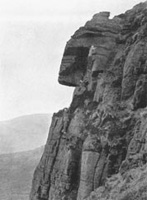 Members’ notes of their climbs on Laddow were printed in the Club’s first Annual Reports and then in the Journals. The Journals began in 1907 and have continued annually. From the notes a guide to 40 climbs on Laddow was printed in the 1911. In 2002 a special meet was held there as part of the Club’s Centenary Celebrations and to commemorate the Club’s early work on it.
Members’ notes of their climbs on Laddow were printed in the Club’s first Annual Reports and then in the Journals. The Journals began in 1907 and have continued annually. From the notes a guide to 40 climbs on Laddow was printed in the 1911. In 2002 a special meet was held there as part of the Club’s Centenary Celebrations and to commemorate the Club’s early work on it.
The Club was strong on innovation. The Club’s first hut, the first in 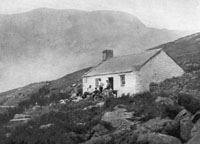 the British Isles, was opened in 1912. It was primitive. One rule was: ‘Sanitary Arrangements: these should be executed in the rocks not less than 100 yards from the rear of the hut’. The hut was initially a great success, but its use declined during the war. Theft and vandalism forced the closure of the hut in 1920. It was 1929 before a second hut in Wales was found at Tal-y-Braich in the Ogwen valley.
the British Isles, was opened in 1912. It was primitive. One rule was: ‘Sanitary Arrangements: these should be executed in the rocks not less than 100 yards from the rear of the hut’. The hut was initially a great success, but its use declined during the war. Theft and vandalism forced the closure of the hut in 1920. It was 1929 before a second hut in Wales was found at Tal-y-Braich in the Ogwen valley.
In 1908 the Club held its first meet in Scotland, at Arrochar which started a tradition of holding the annual Easter Meet north of the Border. Rooke Corbett started another tradition with a “Moonlight Ramble”. Walks involving an overnight section have remained a strong event, despite frequent absence of the moon.
After the Armistice in 1918 the Rucksack Club expanded and its members were at the forefront of British mountaineering. The Manchester area had been a fine base from which members had climbed hard on Peak District gritstone. In the 20’s and 30’s the greater crags of the Lake District and North Wales were increasingly explored by members. H.M.Kelly was particularly active in the Lakes, and in North Wales A.S.Pigott led a team climbing at the highest standard. His eponymous climb on Clogwyn d’ur Arddu in 1926 was a major advance in Welsh climbing, this was followed by more first ascents in Scotland. Maurice Linnell was also climbing at the highest standard, and a leader in a wave of exploration. Tragically, he was killed in 1934 on Ben Nevis whilst climbing with Colin Kirkus. He was 25. Had the accident not occurred they would probably have become the leading climbing partnership of the age.
 Complementing the climbers a strong group of walkers set high standards. In 1919 Eustace Thomas and party initiated the “Circuit of the Derwent Watershed” which has now become the High Peak Marathon, and in the same year made the first traverse of the “Welsh Threes” with Rooke Corbett and A.W.Wakefield. Seemingly insatiable, Thomas went on to break the Fell Record and become the first Briton to complete the Alp 4000 metre summits. The Marsden-Edale, Colne-Rowsley and Shap-Wasdale were amongst walks enjoyed or endured by members.
Complementing the climbers a strong group of walkers set high standards. In 1919 Eustace Thomas and party initiated the “Circuit of the Derwent Watershed” which has now become the High Peak Marathon, and in the same year made the first traverse of the “Welsh Threes” with Rooke Corbett and A.W.Wakefield. Seemingly insatiable, Thomas went on to break the Fell Record and become the first Briton to complete the Alp 4000 metre summits. The Marsden-Edale, Colne-Rowsley and Shap-Wasdale were amongst walks enjoyed or endured by members.
The extreme difficulties when rescuing a casualty from Laddow and another from Crib Goch 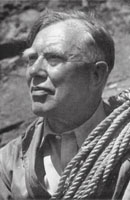 led to the Club forming a Stretcher Sub-committee. This joined with a similar Fell & Rock Climbing Club committee and included Pigott, Thomas and Wilson Hey. From this beginning the Mountain Rescue Committee was formed in 1936. The “Thomas Stretcher” evolved, used for many years by Mountain Rescue Teams. Wilson Hey supplied morphia to the teams and was prosecuted for this in 1949. However, as a result regulations were changed and the teams were then allowed to carry morphia. Fred Pigott received the OBE for his services to Mountain Rescue, as did Noel Kirkman who succeeded him.
led to the Club forming a Stretcher Sub-committee. This joined with a similar Fell & Rock Climbing Club committee and included Pigott, Thomas and Wilson Hey. From this beginning the Mountain Rescue Committee was formed in 1936. The “Thomas Stretcher” evolved, used for many years by Mountain Rescue Teams. Wilson Hey supplied morphia to the teams and was prosecuted for this in 1949. However, as a result regulations were changed and the teams were then allowed to carry morphia. Fred Pigott received the OBE for his services to Mountain Rescue, as did Noel Kirkman who succeeded him.
Before the 1950s few members had the time or the funds needed for travel abroad. Despite this some members were active in the Alps and farther afield. First ascents were recorded in the Caucasus, on Lhonak Peak in the Sikkim Himalaya and in the Lofoten Islands.
Activities were greatly curtailed during the Second World War. Walks and climbing meets became local to the Peak District. Pent-up enthusiasm broke out as restrictions were lifted after 1945. P.R.J.Harding , and others, led first ascents on gritstone and Trilon on Carreg Wastad to mark the opening of the Club’s new hut, Beudy Mawr in the Llanberis Pass. Ken Davidson arrived in Langdale for a week’s hard climbing – straight from demob wearing his demob suit.
The Club’s Golden Jubilee in 1952 was marked by a new long-distance walk linking the two highest pubs in England, the Tan Hill and Cat and Fiddle Inns. The 120 miles over the highest ground between them was covered in 54 hours. It is still repeated from time to time – but so far no “double” has been recorded.
Longish walks have remained popular and well-attended. The first “Scottish Fours” – linking all the highest Munros from Ben Nevis to Cairngorm entirely on foot – was first accomplished in 1954. The Colne – Rowsley walk – a favourite – was given a winter crossing in difficult conditions. The Barmouth – Aber was instituted in 1959 and felt to be exacting but became overshadowed by the Welsh Horseshoe: a four-day three-night affair covering the Welsh Threes, Rhinogs, Cader Idris, Arans and Berwyns. The Marsden – Edale is the traditional start to each New Year, usually with a large attendance. A smaller group start from Edale and do a double, and two members once showed their brawn by completing a “double double”.
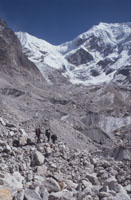 The Himalaya became an attraction to members as opportunities widened in the 1950s with members active on Annapurna, Disteghil Sar, Trivor, Kanchenjunga, the Menlungtse area and in the Caucasus. With experience gained two major expeditions were organised by the Club and led by Joe Walmsley. The first, to Masherbrum (K1) in the Karakoram in 1957 came to within 300 feet of the summit, (25660 ft). The second was to Everest’s neighbour, Nuptse, when the summit at 25850 feet was reached on two successive days. Further expeditions have taken place in the Hindu Kush, Karakoram and Nepal.
The Himalaya became an attraction to members as opportunities widened in the 1950s with members active on Annapurna, Disteghil Sar, Trivor, Kanchenjunga, the Menlungtse area and in the Caucasus. With experience gained two major expeditions were organised by the Club and led by Joe Walmsley. The first, to Masherbrum (K1) in the Karakoram in 1957 came to within 300 feet of the summit, (25660 ft). The second was to Everest’s neighbour, Nuptse, when the summit at 25850 feet was reached on two successive days. Further expeditions have taken place in the Hindu Kush, Karakoram and Nepal.
Small but well-organised expeditions have continued to be made to many of the world’s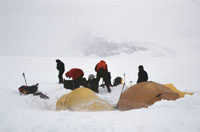 mountainous regions. Greenland has become increasingly popular: in 1982 an enterprising party repeated Nansen’s first crossing. Members have crossed South Georgia following Shackleton’s remarkable feat and most recently a member failed to kite from the South Pole – due to a complete absence of wind.
mountainous regions. Greenland has become increasingly popular: in 1982 an enterprising party repeated Nansen’s first crossing. Members have crossed South Georgia following Shackleton’s remarkable feat and most recently a member failed to kite from the South Pole – due to a complete absence of wind.
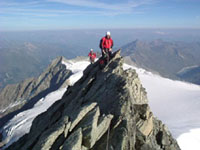 Nearer home, the Alps have provided members with routes from the North Faces to gentler levels. During the yearly Alpine Meets routes have varied from exacting to modest according to circumstance: septuagenarians etc. are allowed (a little) discretion. (Peter Harding soloed the Matterhorn, aged 70). Brian Cosby became the second member to complete the 4000 metre summits in 1982.
Nearer home, the Alps have provided members with routes from the North Faces to gentler levels. During the yearly Alpine Meets routes have varied from exacting to modest according to circumstance: septuagenarians etc. are allowed (a little) discretion. (Peter Harding soloed the Matterhorn, aged 70). Brian Cosby became the second member to complete the 4000 metre summits in 1982.
North America became popular in the 1980s and has become increasingly so. The big walls of Yosemite are a great but not the only attraction, the Lotus Flower Tower in the Yukon, the Devil’s Tower in Wyoming and the Grand Canyon have been climbed and explored.
A major development occurred in 1990 when women were admitted to membership. In 1995 the Club opened its Scottish hut, Craigallan, to complement its huts in England, (High Moss in Dunnerdale), and in Wales, (Beudy Mawr in The Pass). A “Wednesday Walkers” group of members and friends who enjoy pleasant walking was formed in 1989 and has held a walk without exception every Wednesday since, besides enjoying numerous walking holidays abroad.
An enterprising experiment was made in March 1970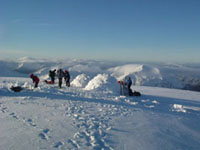 to test the relative merits of a tent, a snowhole and an igloo overnight on Ben Nevis. The igloo proved superior, and ever since an “Igloo Meet” has been attempted on some Munro each Spring. The success rate is about 50%. Some desperate retreats have been survived. ” Scottish Island Meets” commenced in 1975 when it was found possible to reach and return from one of the Small Isles in a longish weekend. These have been very popular and have continued, often farther afield as MacBraynes permit.
to test the relative merits of a tent, a snowhole and an igloo overnight on Ben Nevis. The igloo proved superior, and ever since an “Igloo Meet” has been attempted on some Munro each Spring. The success rate is about 50%. Some desperate retreats have been survived. ” Scottish Island Meets” commenced in 1975 when it was found possible to reach and return from one of the Small Isles in a longish weekend. These have been very popular and have continued, often farther afield as MacBraynes permit.
For many years a meet has been held during each weekend of the year, and although walking and climbing meets predominate, caving, fell-running, canoeing, skiing, mountain biking and even a ceilidh appear regularly. (And also hut maintenance weekends).

